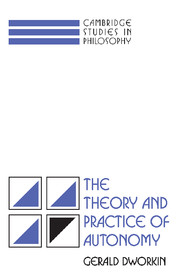Book contents
- Frontmatter
- Contents
- Preface
- Acknowledgments
- PART I THEORY
- PART II PRACTICE
- 6 Consent, representation, and proxy consent
- 7 Autonomy and informed consent
- 8 Paternalism: some second thoughts
- 9 The serpent beguiled me and I did eat: entrapment and the creation of crime
- 10 Behavior control and design
- Epilogue
- Bibliography
- Index
10 - Behavior control and design
Published online by Cambridge University Press: 05 June 2012
- Frontmatter
- Contents
- Preface
- Acknowledgments
- PART I THEORY
- PART II PRACTICE
- 6 Consent, representation, and proxy consent
- 7 Autonomy and informed consent
- 8 Paternalism: some second thoughts
- 9 The serpent beguiled me and I did eat: entrapment and the creation of crime
- 10 Behavior control and design
- Epilogue
- Bibliography
- Index
Summary
What is wrong with it [the world of Walden Two]? Only one thing: somebody “planned it that way.” If these critics had come upon a society in some remote corner of the world which boasted similar advantages, they would undoubtedly have hailed it as providing a pattern we all might well follow – provided that it was clearly the result of a natural process of cultural evolution. Any evidence that intelligence had been used in arriving at this version of the good life would, in their eyes, be a serious flaw.
A cultural practice is not the less effective in determining the behavior characteristics of a group because its origins are accidental. But once the effect upon behavior has been observed, the source of the practice may be scrutinized more closely. Certain questions come to be asked. Why should the design of a culture be left so largely to accident? Is it not possible to change the social environment deliberately so that the human product will meet more acceptable specifications?
In this essay I shall consider an argument that is often made in discussions of methods of influencing people's behavior. This argument states that control of one person by another is constantly taking place, but in an implicit and unconscious fashion, and that it would be preferable for control to take place on a systematic and explicit basis. Here is a small sample of these arguments.
- Type
- Chapter
- Information
- The Theory and Practice of Autonomy , pp. 150 - 160Publisher: Cambridge University PressPrint publication year: 1988
- 1
- Cited by

